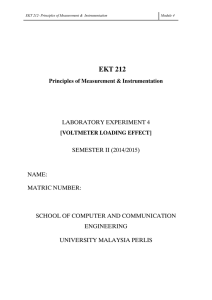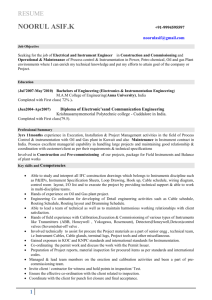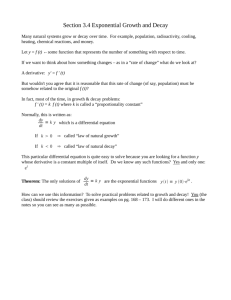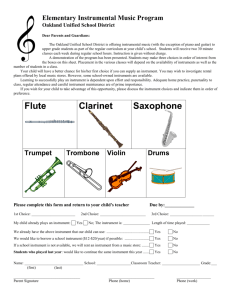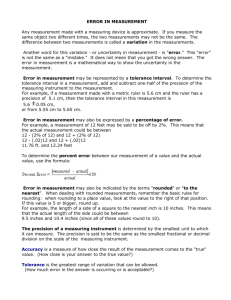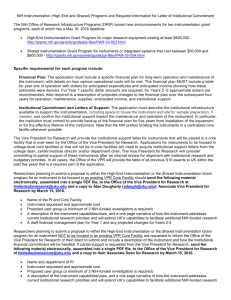Lab 1 Introduction to Measurement
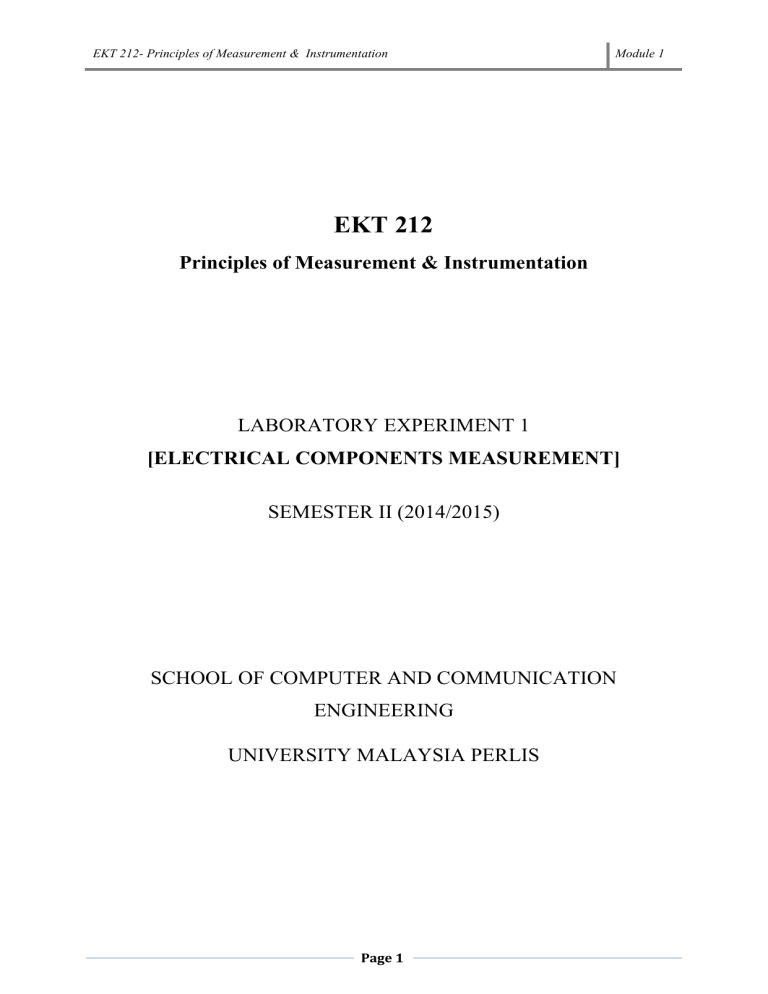
EKT 212- Principles of Measurement & Instrumentation
EKT 212
Principles of Measurement & Instrumentation
LABORATORY EXPERIMENT 1
[ELECTRICAL COMPONENTS MEASUREMENT]
SEMESTER II (2014/2015)
SCHOOL OF COMPUTER AND COMMUNICATION
ENGINEERING
UNIVERSITY MALAYSIA PERLIS
Page 1
EKT 212- Principles of Measurement & Instrumentation
ELECTRICAL COMPONENTS MEASUREMENT
Concept of Measurement
Measurement is process of comparing an unknown quantity with an accepted standard quantity. It involves connecting a measuring instrument into the system under consideration and observing the resulting response on the instrument.
Any measurement is affected by many variable, therefore the result rarely reflect the expected value. Some factors are related to the person using the instrument. The degree to which measurement nears to the expected value is expressed in term of the error of measurement.
Error may express in absolute error or percentage of error.
Measurement process
Measurement process is process included all information, instrument, and operation which related to all aspect of technique, principle, behavior and quality value measurement standard.
There are some tips for measurement process;-
1.
Before measurement
Procedure of measurement – identified parameter/variable to be measured
Characteristic – must know parameter to be measured for example measure voltage in dc or ac
Quality – time, instrument ability
Instrument/equipment – use suitable instrument/equipment for measurement for example analog or digital multi-meter
2.
During measurement
Safety – should know instrument limitation, overload effect, electric shock
Sampling- if the value is not stable, value must be taken more than once
Instrument/equipment Setting
3.
After measurement
Each data should be analyzed, comparing with expected/calculated value, error measurement, statistically and result must be accurate and complete.
Page 2
EKT 212- Principles of Measurement & Instrumentation
EKT 212
PRINCIPLES OF MEASUREMENT AND INSTRUMENTATION
LABORATORY MODULE 1
[DC VOLTAGE & MEASUREMENT]
SEMESTER II (2014/2015)
NAME: ………………………………………………………… MATRIX NUMBER:……………….
NAME: ………………………………………………………… MATRIX NUMBER:…………….…
PROGRAM : …………………………………………………………………………………………...
GROUP : ………………………………………………………………………………………………..
Page 3
EKT 212- Principles of Measurement & Instrumentation
Error in measurement
1.
absolute error, e = |Y n
-X n
|
Y n
= expected value
X n
= measured value
2.
Percentage of error, e
e x 100
Y n
Component and Equipment
Resistor
1kΩ
and multiple R (same value)
Power Supply
Bread Board
Jumper Wire
Y n
Y n
X n x 100
PROCEDURE
1.
Using color code method, record the value of the resistor in Table 1 . Y n
,
Resistor
(Nominal Value ± tolerance) 1 st
Table 1
Color Bands – Color
2 nd 3 rd 4 th
2.
Given of multiple of R with a same value, using multi-meter, measure each resistor and record its value in Table 2 . a
R b
Figure 1
3.
From the measurement done in Procedure 1 and 2, calculate the i.
Absolute error = ……………………………….. ii.
Percentage of error = …………………………… iii.
Relative accuracy = ……………………………..
Page 4
EKT 212- Principles of Measurement & Instrumentation iv.
Percentage of accuracy =…………………………. v.
Precision = ……………………………………….
*Write down your result in table 1 and table 2.
No. Measured
Value, X n
Absolute error
Table 2
Percentage of error
Relative accuracy
Percentage of accuracy
Precision
1
2
3
4
5
6
7
8
9
10
4.
From the experiment, discuss the accuracy, error and precision.
______________________________________________________________________
______________________________________________________________________
______________________________________________________________________
______________________________________________________________________
______________________________________________________________________
______________________________________________________________________
______________________________________________________________________
5.
Conclusion
______________________________________________________________________
______________________________________________________________________
______________________________________________________________________
______________________________________________________________________
______________________________________________________________________
______________________________________________________________________
____________________________________________________________________
Page 5
